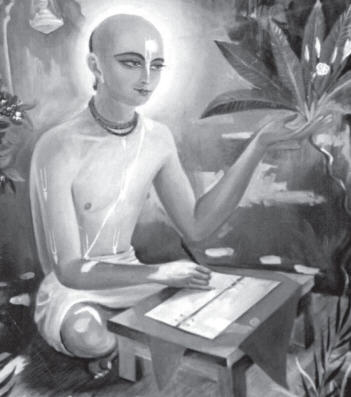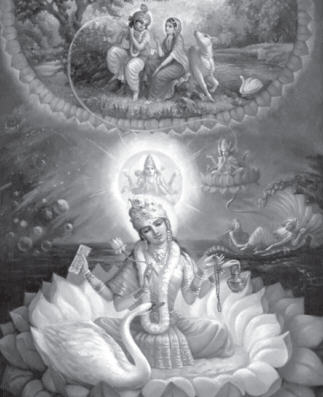A Deeper perspective on the first verse of the Srimad-Bhagavatam.
After having divided the original Yajurveda four-fold, Lord Vedavyasa manifested the fifth-veda i.e. the Puranas and the Itihasa (Mahabharata). Fot deriving their essence, the five hundred and forty aphorisms of Vedanta were also made manifest by him. Even after such a tremendous accomplishment, he remained dissatisfied internally. Srila Baladeva Vidyabhusana writes in his Sri Jivapathatippani: "Aparitustena iti Puranajate brahmasutre ca bhagavat paramaishvaryyamadhuryayoh sandigdhataya gudhataya coktestatra tatra caparitosah" the cause for dissatisfaction was the unclear, perplexing, confidential, and imperceptible manner in which the features of Lord Krsna's majesty and sweetness were described in the Puranas and Brahmasutra. When Veda Vyasa was lamenting thus, Sri Narada Muni, his divine preceptor arrived and made him understand the futility of his writings that were devoid of the transcendentally pure glories of Lord Krsna.
bhavatanudita-prayam
yaso bhagavato malam
yenaivasau na tusyeta
manye tad darsanam khilam
(S.B. 1.5.8)
Description of all other types of temporary dharmas and cheating ptopensities along with the knowledge of impersonal Brahman that were prescribed in the earlier treatises of Vyasa were not able to please the Lord. Such temporary religions by their very nature remain incomplete. In addition, Vyasadeva had not described in great detail the spotless glories of Lord Krsna as he had the four purusarthas (varnasrama dharma, arrha, kama, and moksa). Having been inspired by Sri Narada, Sri Vyasadeva manifested Srimad Bhagavatam, the ripened fruit of Vedas from his trance. Having attained Srimad-Bhagavatam, he was fully self satisfied. Baladeva Vidyabhuana comments: "Sri bhagavate tu tayostad vilaks ha nata yoktesta tra paritosa iti bodhyam" – because in Srimad-Bhagavatam, the Lord's features of opulence and sweetness were portrayed in full clarity and peculiarity, Vyasadeva found satisfaction in it.
Srimad Bhagvatam The Essence Of All Scriptures

Srila Jiva Gosvami Composes His Tattva-Sandarbhas
Srila Jiva Goswami mentions in Tattva sandarbha (10) "Tena Bhagavata nijasutranamakritim bhashyabhutam Samadhi labdhamavirbhavitam. Yasminn eva sarvasastrasamanooyo drishyate" Srimad Bhagavatam is the natural commentary on Brahmasutras wherein the reconciliation of all the Sastras (revealed scriptures) is observed. The doubt as to how can the purport (tatparya) of all the srutis, smrtis, nigamas and agamas be said to belogically included in Srimad-Bhagavatam is also solved by Sri Jiva Goswami. "Sarvavedartha sutralakshanam Gayatrim adhikritya pravartitatvat" – Lord Krsna establishes himself as the full knowable object from the vedas and as the target (varcya referred to) of the vedas (vacaka reference maker) in the Bhagavad-gita as follows: Veda is ca sarvair aham eva vedyam [Bg. 15.15]". Since the conclusion of the Vedas finds rest in Lord Krsna and because the final definition of the Vedas is concisely narrated in the Brahma-Gilyatrl Mantra ( the Mother of Vedas), Srimad Bhagavatam having been established on the basis of that Gilyatri, has the purport and essence of all the Vedas.This fact has been corroborated in Garuda Purana as follows: "artho 'yam brahma-sutranam bharatarthavinirnayah gayatri-bhasya-rupo 'sau vedarthaparibrmhitah" – Srimad-Bhagavatam is the meaning of Brahmasutras (Vedanta -darsana) , the judgement-maker or the deciding authority on the true purport of Mahabharata, the commentary of the Gayatri, and is full of the conclusions of Vedas. Sriman Mahaprabhu Caitanyadeva has instructed Sanatana Goswami in this matter: yei sutra-karta, se yadi karaye vyakhyana tabe sutrera mula artha lokera haya jnana (C.C. Madhya 25.93) If the compiler of the aphorisms himself comments on those aphorisms, only then their original intended true meanings are revealed to the people in general. Pondering like this, Vedavyasa summarized the purport of Vedas and Upanisads in Brahmasutras. The particular mantras of Vedas and Upanisads that have been transformed into aphorisms in Vedantasutras, are found in prose in Srimad-Bhagavatam.
For this reason, Srimad-Bhagavatam is a natural commentary on Vedanta and the meanings of the verses of Srimad-Bhagavatam are the same as those of the mantras of Upanisads.
SRlMAD-BHAGAVATAM AND GAYATRI

Srimad Bhagavatam is Non-Diffrent From The Gayatri Mantra
Further evidence is also available in Matsya Purana (53.20,22,23): "Yatradhikritya Gayatrim varnyate dharmavistarah / Vrtrasuravadhopetam tad Bhagavatamishyate // likhitva tacca yo dadyaddhemasimhasamanvitam / praushthapadyam paurnamasyam sa yati paramam gatim // ashtadasahasahasrani puranam tat prakirtitam //" The translation:
"Wherein the supreme dharma is elaborated upon on the foundation of Gayatri and where the killing of the Vrtrasura demon is mentioned is known by the name Srimad Bhagavatam. One, who, on the full moon day gives away in charity Srimad-Bhagavatam establishing it on a golden throne by personally writing it wholly, will attain the highest destination. Srimad-Bhagavatam is full of eighteen-thousand verses."
Sri Jiva Goswami writes: Atra Gayatrishabdena tatsuchaka tadavyabhichari dhimahi- pada samvaIita -dadartha evesyate" – here, in the Matsya Purana verse, the word "Gayatrim" means the definition of whole BrahmaGayatri along with the verb "dhimahi" which is not only indicative of Gayatri but also non-different from it, being a constituent of it.
In the first verse of Srimad Bhagavatam, gayatri is mentioned as "satyam param dhimahi" – "we meditate on the absolute truth" and in the last section (S.B.12.13.19) it is described as "vimalam visokamamritam satyam param dhimahi" " I meditate on the Absolue Truth which is pure, free from lamentation, and eternal." Vedas (Brhadaranyaka Sruti 4.5.6) mention: "tad brahma nididhyasitavyam vijijnasasveti" – "Supreme Lord has to be inquired and contemplated(meditated) upon". Gayatri and Srimad- Bhagavatam also mention contemplation of Parambrahma – Absolute Truth as "dhimahi param satyam". In this way, the meaning of the Vedas, the Gayatri, and the Srimad- Bhagavatam are one and the same without any difference in substance.
To the arguing contention as to why the Gayatri is not openly mentioned in Srimad-Bhagavatam, Sri Jiva Goswami repli es . "Sarvqam mantranam adirupasyatasyah sakjatkathananarhawat" – since the form of Brahma-Gayatri is not to be revealed openly and women, sudras, friend of brahmanas (brahmabandhus), and mleccha-yavanas are not allowed entrance in the study of Vedas, the Gayatri being a Vedic mantra, also cannot be heard of and recited by them. However, the essence of t he Vedas is avail able in the Mahabharata, which is composed by Vedavyasa for the benefi ts o f for women, sudras and antyajas (ou tcastes). stri-sild ra dvijabandhunam trayi na sruti-gocara (S.B. 1.4.25). And Srimad-Bhagavatam is making the purport of Mahabharata very transparently crystal clear ("bharatartha-vinirnayah"), and it also is also permitting women, Sudras, and dvijabandhus into the perusal of its very self.
For t his reason solely, it cannot mention the Gayatri-mantra directly.
RadhaKrsna Dasa, 19, is a disciple of His Holiness Gopal Krsna Goswami Maharaja. He lives in Vrndavana where he is pursuing studies of Sanskrit and scriptures.
